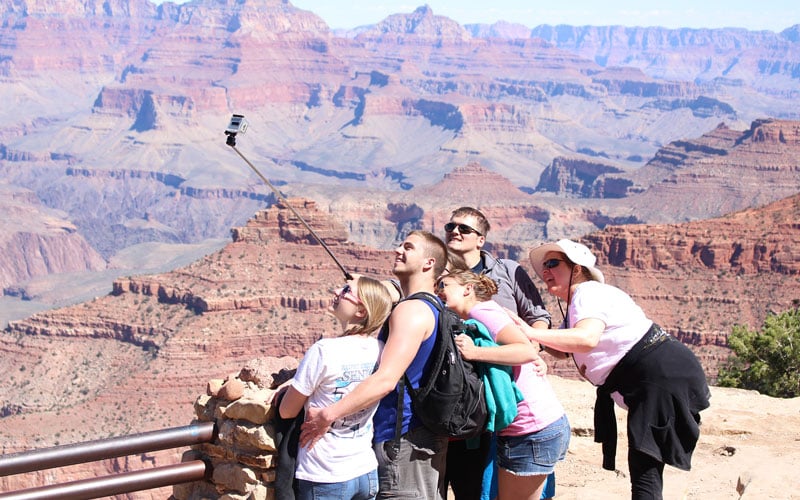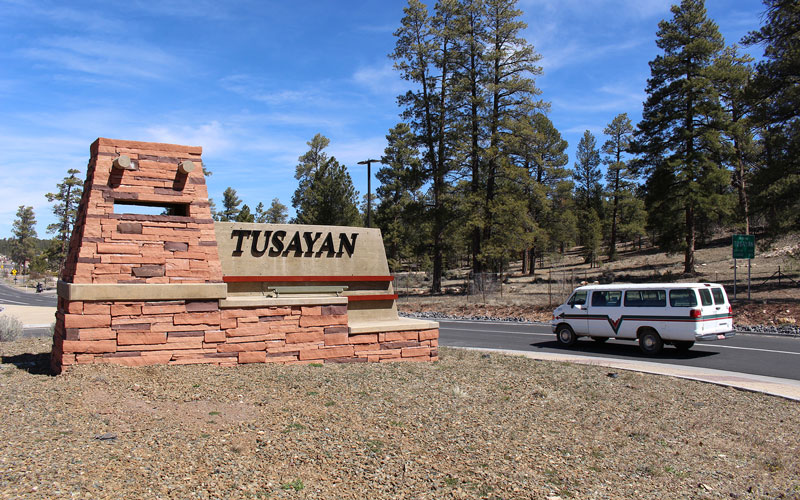
National parks in Arizona attracted 12 million visitors last year, according to the National Park Service. Many went to the Grand Canyon, like these tourists. (Photo by Sophia Kunthara/Cronkite News)

The National Park Service said visitors to parks in Arizona last year spent $995 million at nearby businesses, like those in the town of Tusayan, the gateway to the Grand Canyon. (Photo by Sophia Kunthara/Cronkite News)
WASHINGTON – The 12 million people who visited national parks in Arizona last year spent more than $995 million with nearby businesses, a $63 million increase from the year before, the National Park Service said.
The service’s annual Visitor Spending Effects Report said that spending supported more than 15,000 jobs and generated $1.5 billion in economic activity for the state.
That was part of a national record 331 million visitors to the 471 National Park Service sites across the country in 2016. They spent $18.4 billion on lodging, food, gas, admissions, local transportation and other fees, generating an estimated $34.9 billion in economic activity.
“National Parks are America’s treasure, which provide magnificent outdoor recreation opportunities and serve as economic engines for local communities,” Interior Secretary Ryan Zinke said in a statement with the April report. “With continued record visitation it’s time to start thinking about accessibility and infrastructure.”
But experts in Arizona said it’s past time to think about improving infrastructure, saying long-overdue maintenance could “ultimately put Arizona’s cash cow at risk.” And one said that early indications on Trump administration plans to spend on Interior and the National Park Service “aren’t good.”
“The tourism and dollars related to tourism in Arizona are really the backbone of our state’s economy,” said Roger Clark, program director for the Grand Canyon Trust. “Yet, neither state nor federal agencies really invest what is needed to make sure that the Grand Canyon remains the desirable destination it is today.”
A Senate bill introduced in March would dedicate more than $10 billion over the next 30 years to park maintenance, but it has yet to get a hearing. Clark said the investment in infrastructure pales in comparison to the value parks bring to the state’s economy.
“We’re enjoying the economic benefits of the park without making investments necessary to ensure its quality and availability for future generations,” he said.
He said the aging water system in the Grand Canyon is in dire need of redesign and replacement, an issue he called one of the most-pressing among all the parks in the nation.
“The park service is looking at options so that the constant breaking of the canyon pipeline due to intense pressure and the really old piping system needs to be replaced,” said Clark, adding that the system is “holding on without the budget to really fix it.”
At times during busy seasons, he said, the park has almost had to shut down due to the failing water system, noting that “if that happens, the people that rely on the tourism economy are going to lose lots of money.”
Kevin Dahl, Arizona’s senior program manager for the National Parks Conservation Association, echoed Clark’s concerns.
“The pipeline that supplies all that water is 50 years old, it’s long past the time when it should have been replaced,” Dahl said.
That is just one of many serious infrastructure needs that should be addressed at the canyon, Dahl said.
Despite those problems, however, Dahl said he is optimistic about the future of the parks. He pointed to a bipartisan bill in the Senate that would dedicate funding for parks maintenance for the next 30 years.
“President Trump has talked about the need for infrastructure and renewal in our country,” Dahl said. “That’s just as true in the national parks as it is elsewhere. We hope the very special places get the attention they deserve.”